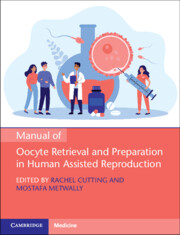Book contents
- Manual of Oocyte Retrieval and Preparation in Human Assisted Reproduction
- Manual of Oocyte Retrieval and Preparation in Human Assisted Reproduction
- Copyright page
- Contents
- Contributors
- Chapter 1 The Ovary: A General Overview of Follicle Formation and Development
- Chapter 2 Monitoring of Ovarian Stimulation
- Chapter 3 Theatre Design, Equipment and Consumables for Oocyte Retrieval
- Chapter 4 Conscious Sedation and Analgesia for Oocyte Retrieval
- Chapter 5 Practical Clinical Aspects of Oocyte Retrieval
- Chapter 6 Challenges during Oocyte Retrieval
- Chapter 7 Complications of Oocyte Retrieval
- Chapter 8 The Nurse’s Role during Oocyte Retrieval
- Chapter 9 Laboratory Design, Equipment and Consumables for Oocyte Retrieval
- Chapter 10 Quality Management Requirements for Oocyte Collection
- Chapter 11 Morphological Assessment of Oocyte Quality
- Chapter 12 Oocyte Preparation for Conventional In Vitro Fertilisation and Intracytoplasmic Sperm Injection
- Chapter 13 Oocyte Retrieval: The Patient’s Perspective
- Index
- Plate Section (PDF Only)
- References
Chapter 9 - Laboratory Design, Equipment and Consumables for Oocyte Retrieval
Published online by Cambridge University Press: 09 November 2022
- Manual of Oocyte Retrieval and Preparation in Human Assisted Reproduction
- Manual of Oocyte Retrieval and Preparation in Human Assisted Reproduction
- Copyright page
- Contents
- Contributors
- Chapter 1 The Ovary: A General Overview of Follicle Formation and Development
- Chapter 2 Monitoring of Ovarian Stimulation
- Chapter 3 Theatre Design, Equipment and Consumables for Oocyte Retrieval
- Chapter 4 Conscious Sedation and Analgesia for Oocyte Retrieval
- Chapter 5 Practical Clinical Aspects of Oocyte Retrieval
- Chapter 6 Challenges during Oocyte Retrieval
- Chapter 7 Complications of Oocyte Retrieval
- Chapter 8 The Nurse’s Role during Oocyte Retrieval
- Chapter 9 Laboratory Design, Equipment and Consumables for Oocyte Retrieval
- Chapter 10 Quality Management Requirements for Oocyte Collection
- Chapter 11 Morphological Assessment of Oocyte Quality
- Chapter 12 Oocyte Preparation for Conventional In Vitro Fertilisation and Intracytoplasmic Sperm Injection
- Chapter 13 Oocyte Retrieval: The Patient’s Perspective
- Index
- Plate Section (PDF Only)
- References
Summary
The importance of optimising the environment in which oocytes are collected should not be underestimated, as the quality of the oocytes obtained is a key determinant factor in the success or failure of any subsequent fertility treatment. The laboratory facilities should be well designed and well equipped, meticulously clean and stocked with carefully selected non-reprotoxic consumables. Laboratory personnel should be well trained, working to clearly defined protocols and competent to perform the procedures relevant to their role. Control of the culture conditions and environmental air quality during the oocyte retrieval is as important as the skill of the doctors, nurses and scientists involved. The modern, well-designed and well-equipped laboratory should provide an optimised, consistent and continually monitored environment for all elements of the IVF process including the collection, processing and incubation of gametes and embryos, without causing unnecessary stress or harm at any point during the procedure.
- Type
- Chapter
- Information
- Publisher: Cambridge University PressPrint publication year: 2022



